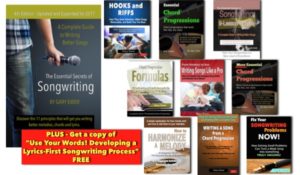In pop songwriting, a bridge (also called a middle-eight) usually occurs after the second chorus, or, in songs that don’t use a chorus, after the second verse. For songs in verse-chorus formats, this is the common position of a song’s bridge:
Verse – Chorus – Verse – Chorus – BRIDGE – Verse – Chorus – (Coda)
or
Verse – Chorus – Verse – Chorus – BRIDGE – Chorus – (Coda)
Listen to “Just Give Me a Reason” (Pink, Jeff Bhasker, Nate Ruess) for a good example of what a bridge can do for a song (2’19”) – it usually helps to build song energy, complete the lyric, and offer more information than the verse and chorus offer.
What sets a bridge apart from most other sections of a song is that it bears little resemblance to any other section. While all verses usually use the same melody but different lyrics, and choruses use the same melody and lyrics, a bridge will offer a new melody, new lyrics, and new chords.
How a Bridge Resembles a Verse
Even though a bridge section typically stands alone, with all new material, there are ways in which a bridge is similar to a verse structure. This means, by the way, that if sometime in the past you wrote a verse-like section but couldn’t get it to work in a song, you may be able to use it as a bridge in some new song.
How are bridges and verses similar? In two very important ways:
- The chord progressions are often of the “wandering” quality, often purposely avoiding the tonic chord as a way of building musical tension.
- The melodies are similarly the kind that move in various directions, upward for building emotional energy, and downward for releasing that energy.
One big difference, though, might lie in the melodic range: if a bridge section tends to build musical energy (as in “Just Give Me a Reason”), the melodic range will be high, usually offering the highest notes of the song.
But if one of the purposes of the bridge is to help energy dissipate (as in John Newman’s “Losing Sleep“, as we hear at about 2’50” of that song), the range will usually at least temporarily move lower before building up again for the final chorus.
The reason I mention this quasi-connection between the verse and the bridge is because it serves as a reminder of a crucial element in successful music of any type: the contrasting of higher and lower musical energy as a song proceeds.
And if verses are usually lower energy, followed by a higher energy chorus, you’ve got two options for the bridge following that chorus:
- Create a section that raises musical energy even higher, or
- Create a section that lowers musical energy.
Many pop songs take the first option, and in those songs you’ll find that the most energetic part of the song is the bridge itself.
And it doesn’t really matter if you choose a high-intensity bridge or a low one. The determining factor that will make a difference for your fan base is this: does your song have a distinctive moment — a climactic plateau? A high-intensity bridge can offer that.
 Written by Gary Ewer. Follow Gary on Twitter.
Written by Gary Ewer. Follow Gary on Twitter.
 “The Essential Secrets of Songwriting” 10-eBook bundle includes several chord progression eBooks, including “Chord Progression Formulas”. Learn how to create chord progressions within seconds using these formulas.
“The Essential Secrets of Songwriting” 10-eBook bundle includes several chord progression eBooks, including “Chord Progression Formulas”. Learn how to create chord progressions within seconds using these formulas.










